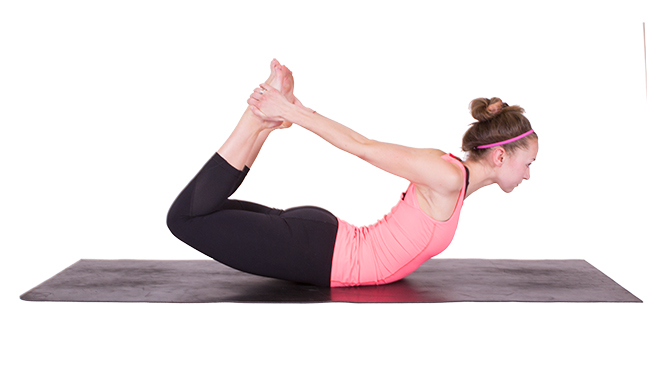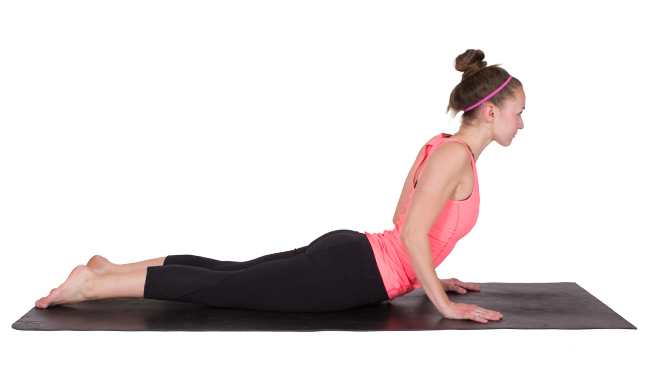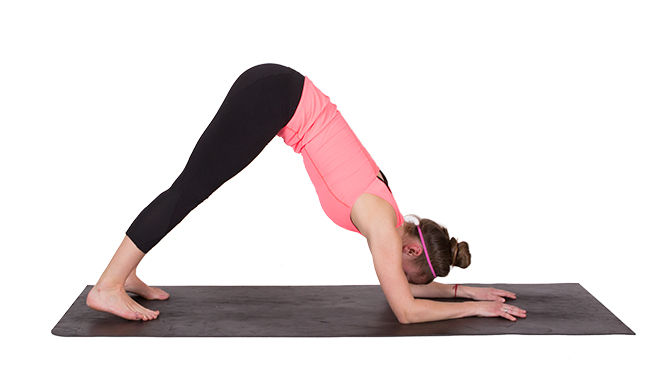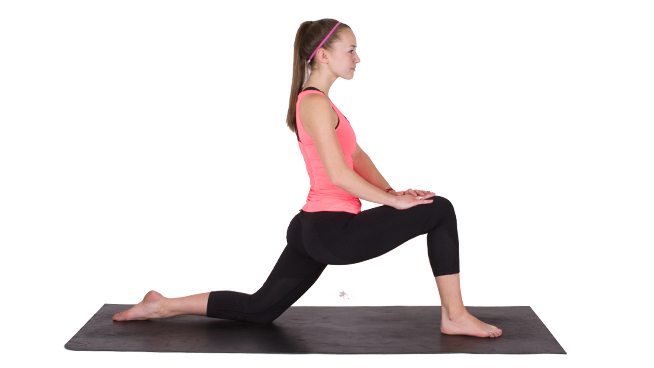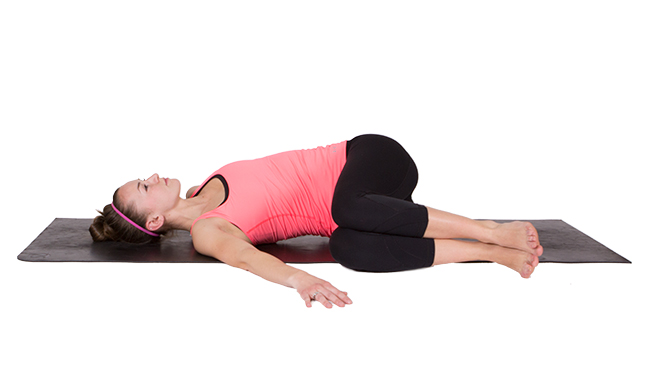People have practiced yoga for centuries. Yoga’s not just for yogis — it’s also pretty legit for athletes.
STACK spoke with some of the smartest yoga instructors in the country to understand which poses are especially beneficial to athletes, and how you can get started with them. Here’s what they recommended.
Backbends
Sitting in class or at a computer can do a number on your body—especially if you are hunched over. The forward-flexed position causes your hip flexor and chest muscles to tighten, limiting hip and shoulder mobility. “Poses such as Half Locust, Camel, Bridge, Wheel, Floor Bow and Standing Backbends, counterbalance this by bringing the body into extension, stretching the chest and shoulder muscles, and strengthening the back,” declares Kiersten Mooney, a Baptise Yoga instructor and owner of Bala Vinyasa Yoga (Naples, Fla.).
How to do it: Lie face down with your hands at your sides and palms facing up. On an exhale, lift your lower legs and bring your heels as close to your buttocks as you can, then reach back with your hands and clasp your ankles. Keep your knees hip-width apart; don’t let them stray wider. On an inhale, lift your ankles away from your buttocks and your thighs off the floor. Keep your tailbone pressed into the floor and your back muscles relaxed. Gaze upward and breathe as you hold for 20 to 30 seconds.
Bridge
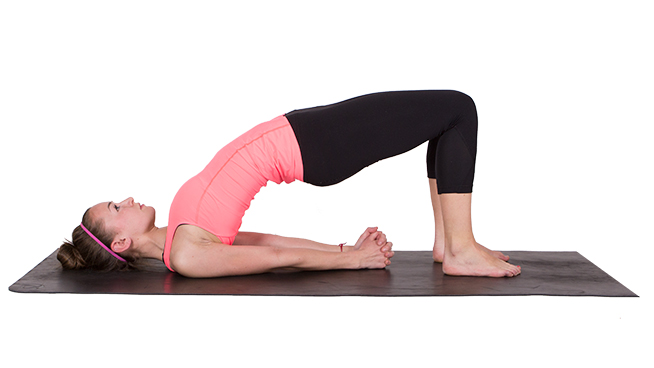
How to do it: Lie on your back and bend your knees to set your feet flat on the floor in front of you. Place your heels as close to your “sit bones” (the bottom of your buttocks) as possible. Exhale and press your arms and feet into the floor to raise your pelvis off the ground. Clasp your hands on the ground underneath your lower back and keep your thighs and feet parallel. Hold for 30 seconds to a minute.
Pigeon Pose Variations
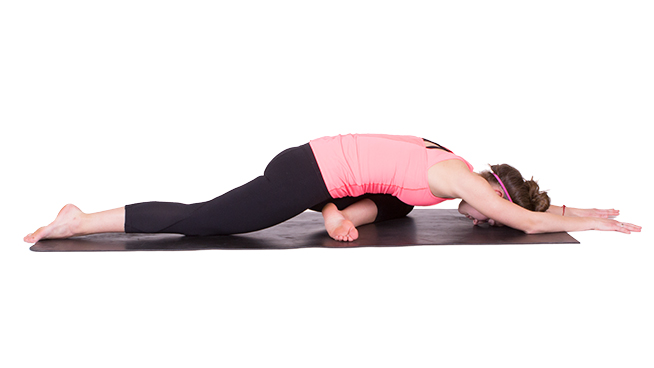
How to do Half Pigeon: Start on all fours with your hands slightly in front of your shoulders. Slide your right knee to your right wrist, so your right shin is on the floor perpendicular to your torso. Slowly slide your left leg behind you until the front of your left thigh is on the floor. Keep the toes of your right foot dorsiflexed (pointing toward your shin) as you lower into what will be an intense stretch through your right hip and buttocks. Hold for a few breaths, then exhale and lower your torso over your right inner thigh, stretching your arms forward. Hold the position for a minute, lift up and out of the pose, and repeat with your left leg forward.
Cobra
After back squatting with heavy weight, you’ve probably felt like your spine needs a good stretching. Cobra addresses this issue. “I use this with all my athletes to release any compression in the spine,” Sterling says. “It allows athletes who lift heavy weight to maintain a healthy spine and prevent injuries.”
How to do it: Lie with your legs straight behind you and the tops of your feet pressed against the floor. Place your hands on the floor beneath your shoulders and spread your fingers wide. Keep your elbows tight against your sides. Inhale, then push through your hands to straighten your arms and lift your chest off the ground, keeping your thighs and feet pressed against the ground. Keep your shoulders down and in (don’t let them creep up toward your ears), and focus on opening your chest and lifting through the sternum. Hold for 15 to 30 seconds, then release and lie flat on the floor.
Dolphin Pose
One tight spot can throw your entire body out of whack, causing mobility issues that can limit your range of motion. That’s why Natalie Sabin, a certified yoga instructor and co-found of SoulStretch Mobile Yoga (Cleveland, Ohio), has her athletes perform the Dolphin Pose. “It stretches the upper back and shoulders, hamstrings, calves and foot arches at the same time,” she explains.
How to do it: Start on your hands and knees, then place your forearms against the ground so your shoulders are directly above your wrists. Press your palms together, curl your toes underneath you, then lift your knees away from the floor. It’s OK to keep your heels lifted and knees slightly bent—in fact, if your lower back rounds, it’s best to keep the knees bent rather than trying to straighten them. Try to lengthen your tailbone and lift your hips toward the ceiling, drawing energy from your inner ankles through your inner legs into your groin. Actively press your forearms against the ground as you do. Hold for 30 seconds to a minute, then return to the floor on an exhale.
Hindu Squats
“This movement performed slowly improves ankle, knee and foot health, mobility and strength,” Sterling asserts. “It also improves the strength of the connective tissue around the ankles and knees, which makes it a great warm-up movement prior to lower-body exercises.” If you don’t have access to weights, you can also perform this Squat variation to build lower-body strength in a full range of motion.
How to do it: Stand with your feet shoulder width apart, positioned at a 45-degree angle. Clasp your hands together in front. Bend your hips and knees to lower into a squat. Continue lowering until your butt touches your ankles and your elbows are in front of your knees. Repeat five to 10 times.
Low-Lunge Crescent Pose
Short on time? Try the Low-Lunge Crescent pose, which according to Sabin, hits many of the large muscle groups in the upper body, lower body and core. “Best of all, it’s a safe pose that anyone can do, so long as they don’t have problems putting weight on the knee that is making contact with the floor,” she says.
How to do it: Perform a lunge, stepping your right foot forward between your hands, making sure your knee is directly above your heel and your left leg is straight behind you. Then drop your left knee to the ground and slide it backward until you feel a stretch through your left thigh and groin. Keep the topside of your left foot pressed firmly against the floor. Inhale and sweep your arms up and to the side, lifting your torso so it’s perpendicular to the floor. Keep your shoulders down and in, and set your gaze slightly upward so your neck is straight. Hold for a minute, then switch sides.
Supported Backbends
“Resting poses like Supported Backbends are always my favorites,” says Sage Rountree, author of The Athlete’s Guide to Yoga and Racing Wisely. “They very lightly stretch tight spots, while giving athletes a chance for deep relaxation, which speeds up recovery.”
How to do it: Using blocks to support your head and thoracic spine (upper back), lie on your back with your arms out to your sides. You can remove the block from underneath your head if you want to deepen the release and can do so without discomfort.
Reclined Easy Twist
Sabin recommends performing the Reclined Easy Twist before and/or after a workout. “This restorative pose helps ease back and neck tension, calms the mind and stretches the torso muscles,” she says.
How to do it: Lie on your back with your knees bent and feet resting on the floor. Draw your knees toward your chest, then on an exhale, lower them to one side. Try to keep your opposite shoulder pressed against the ground as you lower your legs. Hold for 30 seconds to a minute, then draw your knees back to center and lower them to the other side.
Reclining Big Toe Pose
“The Reclining Big Toe Pose targets the hips, thighs, hamstrings, groin and calves at the same time,” Sabin explains. “It strengthens the knees and can target the IT band—a common tight spot in runners—and can relieve backaches and sciatic pain.” And since it can be easily modified with a strap, anyone can do it.
How to do it: Lie with your back on the floor and legs pressed on the ground in front of you. Exhale, bend your left knee, and use your arms to pull your thigh to your chest. From here, either hold your big toe (shown above) or loop a strap around your mid-foot and slowly straighten your knee to extend your leg upward. Keep your opposite heel and both shoulders pressed firmly into the ground and press upward through your right heel. Lower your leg and repeat on the other side.
Read More:
RECOMMENDED FOR YOU
MOST POPULAR
People have practiced yoga for centuries. Yoga’s not just for yogis — it’s also pretty legit for athletes.
STACK spoke with some of the smartest yoga instructors in the country to understand which poses are especially beneficial to athletes, and how you can get started with them. Here’s what they recommended.
Backbends
Sitting in class or at a computer can do a number on your body—especially if you are hunched over. The forward-flexed position causes your hip flexor and chest muscles to tighten, limiting hip and shoulder mobility. “Poses such as Half Locust, Camel, Bridge, Wheel, Floor Bow and Standing Backbends, counterbalance this by bringing the body into extension, stretching the chest and shoulder muscles, and strengthening the back,” declares Kiersten Mooney, a Baptise Yoga instructor and owner of Bala Vinyasa Yoga (Naples, Fla.).
How to do it: Lie face down with your hands at your sides and palms facing up. On an exhale, lift your lower legs and bring your heels as close to your buttocks as you can, then reach back with your hands and clasp your ankles. Keep your knees hip-width apart; don’t let them stray wider. On an inhale, lift your ankles away from your buttocks and your thighs off the floor. Keep your tailbone pressed into the floor and your back muscles relaxed. Gaze upward and breathe as you hold for 20 to 30 seconds.
Bridge

How to do it: Lie on your back and bend your knees to set your feet flat on the floor in front of you. Place your heels as close to your “sit bones” (the bottom of your buttocks) as possible. Exhale and press your arms and feet into the floor to raise your pelvis off the ground. Clasp your hands on the ground underneath your lower back and keep your thighs and feet parallel. Hold for 30 seconds to a minute.
Pigeon Pose Variations

How to do Half Pigeon: Start on all fours with your hands slightly in front of your shoulders. Slide your right knee to your right wrist, so your right shin is on the floor perpendicular to your torso. Slowly slide your left leg behind you until the front of your left thigh is on the floor. Keep the toes of your right foot dorsiflexed (pointing toward your shin) as you lower into what will be an intense stretch through your right hip and buttocks. Hold for a few breaths, then exhale and lower your torso over your right inner thigh, stretching your arms forward. Hold the position for a minute, lift up and out of the pose, and repeat with your left leg forward.
Cobra
After back squatting with heavy weight, you’ve probably felt like your spine needs a good stretching. Cobra addresses this issue. “I use this with all my athletes to release any compression in the spine,” Sterling says. “It allows athletes who lift heavy weight to maintain a healthy spine and prevent injuries.”
How to do it: Lie with your legs straight behind you and the tops of your feet pressed against the floor. Place your hands on the floor beneath your shoulders and spread your fingers wide. Keep your elbows tight against your sides. Inhale, then push through your hands to straighten your arms and lift your chest off the ground, keeping your thighs and feet pressed against the ground. Keep your shoulders down and in (don’t let them creep up toward your ears), and focus on opening your chest and lifting through the sternum. Hold for 15 to 30 seconds, then release and lie flat on the floor.
Dolphin Pose
One tight spot can throw your entire body out of whack, causing mobility issues that can limit your range of motion. That’s why Natalie Sabin, a certified yoga instructor and co-found of SoulStretch Mobile Yoga (Cleveland, Ohio), has her athletes perform the Dolphin Pose. “It stretches the upper back and shoulders, hamstrings, calves and foot arches at the same time,” she explains.
How to do it: Start on your hands and knees, then place your forearms against the ground so your shoulders are directly above your wrists. Press your palms together, curl your toes underneath you, then lift your knees away from the floor. It’s OK to keep your heels lifted and knees slightly bent—in fact, if your lower back rounds, it’s best to keep the knees bent rather than trying to straighten them. Try to lengthen your tailbone and lift your hips toward the ceiling, drawing energy from your inner ankles through your inner legs into your groin. Actively press your forearms against the ground as you do. Hold for 30 seconds to a minute, then return to the floor on an exhale.
Hindu Squats
“This movement performed slowly improves ankle, knee and foot health, mobility and strength,” Sterling asserts. “It also improves the strength of the connective tissue around the ankles and knees, which makes it a great warm-up movement prior to lower-body exercises.” If you don’t have access to weights, you can also perform this Squat variation to build lower-body strength in a full range of motion.
How to do it: Stand with your feet shoulder width apart, positioned at a 45-degree angle. Clasp your hands together in front. Bend your hips and knees to lower into a squat. Continue lowering until your butt touches your ankles and your elbows are in front of your knees. Repeat five to 10 times.
Low-Lunge Crescent Pose
Short on time? Try the Low-Lunge Crescent pose, which according to Sabin, hits many of the large muscle groups in the upper body, lower body and core. “Best of all, it’s a safe pose that anyone can do, so long as they don’t have problems putting weight on the knee that is making contact with the floor,” she says.
How to do it: Perform a lunge, stepping your right foot forward between your hands, making sure your knee is directly above your heel and your left leg is straight behind you. Then drop your left knee to the ground and slide it backward until you feel a stretch through your left thigh and groin. Keep the topside of your left foot pressed firmly against the floor. Inhale and sweep your arms up and to the side, lifting your torso so it’s perpendicular to the floor. Keep your shoulders down and in, and set your gaze slightly upward so your neck is straight. Hold for a minute, then switch sides.
Supported Backbends
“Resting poses like Supported Backbends are always my favorites,” says Sage Rountree, author of The Athlete’s Guide to Yoga and Racing Wisely. “They very lightly stretch tight spots, while giving athletes a chance for deep relaxation, which speeds up recovery.”
How to do it: Using blocks to support your head and thoracic spine (upper back), lie on your back with your arms out to your sides. You can remove the block from underneath your head if you want to deepen the release and can do so without discomfort.
Reclined Easy Twist
Sabin recommends performing the Reclined Easy Twist before and/or after a workout. “This restorative pose helps ease back and neck tension, calms the mind and stretches the torso muscles,” she says.
How to do it: Lie on your back with your knees bent and feet resting on the floor. Draw your knees toward your chest, then on an exhale, lower them to one side. Try to keep your opposite shoulder pressed against the ground as you lower your legs. Hold for 30 seconds to a minute, then draw your knees back to center and lower them to the other side.
Reclining Big Toe Pose
“The Reclining Big Toe Pose targets the hips, thighs, hamstrings, groin and calves at the same time,” Sabin explains. “It strengthens the knees and can target the IT band—a common tight spot in runners—and can relieve backaches and sciatic pain.” And since it can be easily modified with a strap, anyone can do it.
How to do it: Lie with your back on the floor and legs pressed on the ground in front of you. Exhale, bend your left knee, and use your arms to pull your thigh to your chest. From here, either hold your big toe (shown above) or loop a strap around your mid-foot and slowly straighten your knee to extend your leg upward. Keep your opposite heel and both shoulders pressed firmly into the ground and press upward through your right heel. Lower your leg and repeat on the other side.
Read More:

